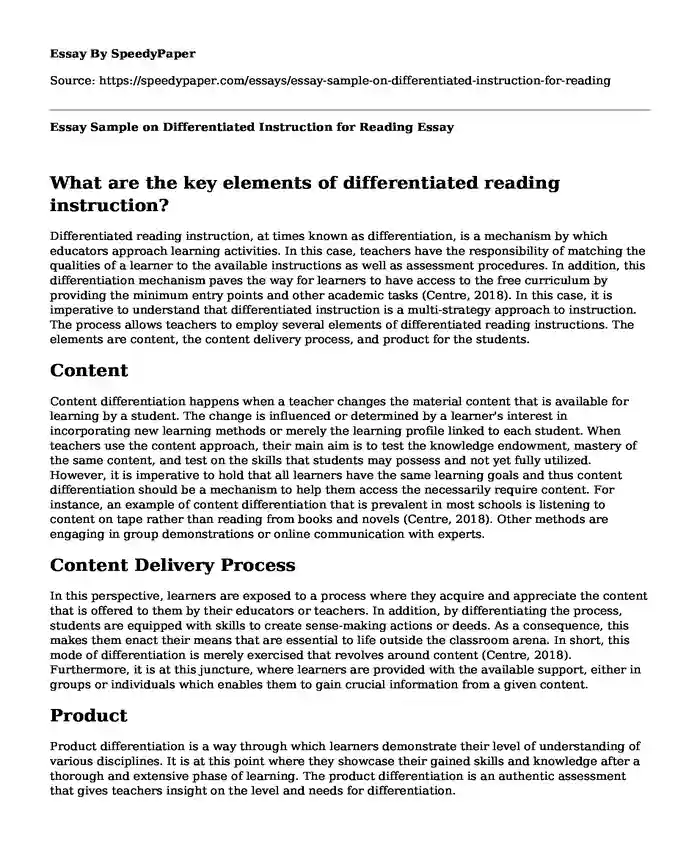What are the key elements of differentiated reading instruction?
Differentiated reading instruction, at times known as differentiation, is a mechanism by which educators approach learning activities. In this case, teachers have the responsibility of matching the qualities of a learner to the available instructions as well as assessment procedures. In addition, this differentiation mechanism paves the way for learners to have access to the free curriculum by providing the minimum entry points and other academic tasks (Centre, 2018). In this case, it is imperative to understand that differentiated instruction is a multi-strategy approach to instruction. The process allows teachers to employ several elements of differentiated reading instructions. The elements are content, the content delivery process, and product for the students.
Content
Content differentiation happens when a teacher changes the material content that is available for learning by a student. The change is influenced or determined by a learner's interest in incorporating new learning methods or merely the learning profile linked to each student. When teachers use the content approach, their main aim is to test the knowledge endowment, mastery of the same content, and test on the skills that students may possess and not yet fully utilized. However, it is imperative to hold that all learners have the same learning goals and thus content differentiation should be a mechanism to help them access the necessarily require content. For instance, an example of content differentiation that is prevalent in most schools is listening to content on tape rather than reading from books and novels (Centre, 2018). Other methods are engaging in group demonstrations or online communication with experts.
Content Delivery Process
In this perspective, learners are exposed to a process where they acquire and appreciate the content that is offered to them by their educators or teachers. In addition, by differentiating the process, students are equipped with skills to create sense-making actions or deeds. As a consequence, this makes them enact their means that are essential to life outside the classroom arena. In short, this mode of differentiation is merely exercised that revolves around content (Centre, 2018). Furthermore, it is at this juncture, where learners are provided with the available support, either in groups or individuals which enables them to gain crucial information from a given content.
Product
Product differentiation is a way through which learners demonstrate their level of understanding of various disciplines. It is at this point where they showcase their gained skills and knowledge after a thorough and extensive phase of learning. The product differentiation is an authentic assessment that gives teachers insight on the level and needs for differentiation.
What teacher preparation is needed to implement differentiated reading instruction?
Differentiated reading instruction is not a simple task to adopt. It requires several measures and deep, well-analyzed thoughts and analysis of situations that allows educators to identify the elements to use. Therefore, some specific preparation procedures are essential to implementing differentiated reading instructions among the learners.
Use of a diagnostic Assessment process
A diagnostic process is an essential tool in determining the readiness aspect from the students. The purpose of these assessments can either be formal or informal depending on the evaluation of a teacher. The method may entail handing out pre-tests, use of KWL charts or other available means (Centre, 2018). The KWL charts test on what learners Know, their tendency to Want to know, and what the students have Learned about a given subject or topic.
Identifying Interest to Know among the students
In this perspective, a teacher is obligated to adopt some strategies that enable them to determine the student interests. For instance, it may be an oral process where learners are to mention their benefits from given topics (Centre, 2018). From these mentions, a teacher may decide to include such benefits in their class schedules or activities.
Evaluate Learning Style and the Effect of the Learning Environment
It is crucial for teachers to prepare on identifying the learning styles and the familiar surrounding environment. The best way to make for this is by identifying and observing student activities. To evaluate the learning environment, teachers ought to determine student behavior in both as an individual or a group (Opitz & Erekson, 2015). It helps in identifying the environmental factors that may affect student learning.
What are some effective grouping strategies for differentiated reading instruction?
The available grouping strategies for teachers are;
Tiered Tasks: In this case, learners are instructed to do a task where the elements of process and product differentiation. The primary need to do this is to determine a student's level of enthusiasm.
Interest Groups: The groups aim at directing students to identify topics that suit them (Opitz & Erekson, 2015).. the primary importance of these groups is to improve on reading skills, and other academic and non-academic activities.
Flexible Grouping: The strategy is useful when students are placed in groups depending on readiness levels or their interest basis. Learners are allowed to choose their groupings based on their preference.
Choice Boards: in this strategy, learners are allowed to choose an activity they would wish to complete. Such activities help in improving a student's skills or product.
References
Centre, A. (2018). Differentiated Instruction for Reading. Retrieved from http://www.readingrockets.org/article/differentiated-instruction-reading
Opitz, M. F., & Erekson, J. A. (2015). Understanding, assessing, and teaching reading: A diagnostic approach. Pearson.
Cite this page
Essay Sample on Differentiated Instruction for Reading. (2022, Aug 01). Retrieved from https://speedypaper.net/essays/essay-sample-on-differentiated-instruction-for-reading
Request Removal
If you are the original author of this essay and no longer wish to have it published on the SpeedyPaper website, please click below to request its removal:
- 12 Angry Men Logical Fallacies Analysis: Free Essay Sample
- Comparison Essay Sample: Renting Vs Owning
- Personal Reflection Essay Sample on the Article: Commodified Agents and Empowered Girl
- Pop Culture: A Trend Among the Youths
- Paper Example on Case Analysis of Valjibhai Stones Company
- Paper Example on Nosocomial Infection With Urinary Catheter-Associated Urinary Tract Infection
- Free Essay on Social Movement: Coercion, Money, Words
Popular categories





